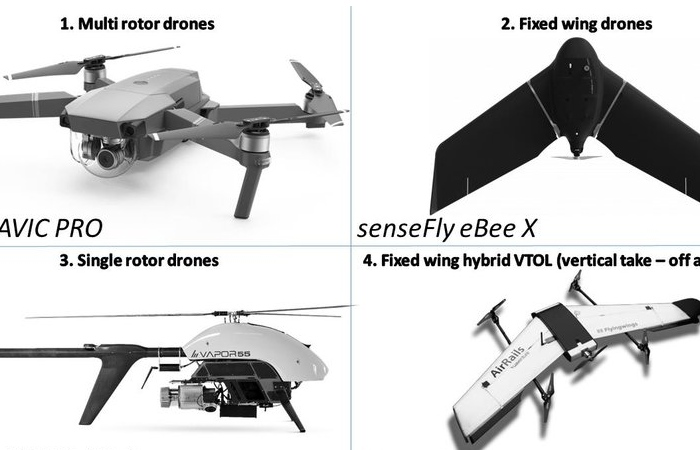Introduction
A drone is a flying robot, formally known as an uncrewed aerial vehicle (UAV), or uncrewed aircraft system, which is an aircraft without any pilot, crew, or passenger. It would be helpful in defense systems and agricultural purposes, as more and more businesses are utilizing drone technology.
Table of Contents
Types of Drones

Many businesses anticipate utilizing the full capabilities of drones in the future. As a result, they are explored extensively across an array of industries, such as real estate, construction, cultivation, e-commerce, efficacies, and media, and performing worldwide.
Founded on the type of aerial platform, there are four major types of drones:
- Multi-rotor drones
- Fixed wing drones
- Single rotor helicopter
- Fixed wing hybrid VTOL
What are the Advantages of Drone?
The advantages of drones are experts that believe these aerial vehicles helpful in the healthcare sector, construction sector, and emergency response services.
Monitoring and Surveillance
monitoring dangerous sites is one of the most significant advantages of drones in military operations, as it may save soldiers from casualties. Drones can also ensure workers’ safety, especially in hazardous situations like radiation monitoring and inspecting high voltage lines.
Aerial Photography
Beginners and seasoned expert pilots use advanced camera drone units for filming, aerial photography, site surveying, and 3D imaging. Who can be the secret to getting a bird’s eye view of a city, beach, or specific building? But, of course, there are drones specifically for photography as well.
They provide a new way to capture places from the air. But in areas or buildings with obstacles, you might want to consider a UAV that is great for obstacle avoidance.
SAR (Search & Rescue)
There are instances when first responders cannot go into a rescue situation due to the severity of the disaster when drones come into play.
Delivery
Drone models are designed for transporting food, packages, and other goods. They used to make deliveries from stores right to your doorstep. Delivery drones can carry 55pounds of goods to your front door.
Agriculture
Drones have also been helpful for the agriculture industry. They mainly come in handy and advantageous for farmers in several ways, such as :
- Optimizing the farm
- Maximizing efficiency
- Reducing physical strain
Drone technology helps farmers save money and their crops by properly monitoring irrigation systems and performance analysis using drones; farmers get complete updates on information about produce. They help spray water, pesticides, and fertilizers on crops at appropriate times.
Disadvantages of Drone
After several years of practice, drones can form a list of typical hazards accompanying their use.
- Short flight time.
- They are easily affected by weather.
- Drone collisions with people. Risk of injury. How does it work?
How does a Drone Work?
Piloting a drone is a faculty within everyone’s reach, provided you train well and know the few rules to follow before starting the flight outdoors. It is also possible to take flight training for the most passionate.
Indeed, the pilot is subject to specific prohibitions such as night flying, overflight of urban areas, sensitive areas (nuclear power plants, military bases), and aviation areas. In addition, as we have formerly mentioned, the Drone must not fly above 150 m altitudes.
The Drone is generally piloted using a radio control (RC) having the appearance of a joystick, but there are many types of radio controls. Some console joysticks, as well as mobile devices (smartphones, tablets, PCs, etc.), can indeed be used to control the aircraft
If you are an apprentice, we advise you to train with mini drones indoors. The goal is to know how to handle the Drone and perform the main movements: take-off, landing, rotation, etc. Do not hesitate to read articles and watch videos of seasoned pilots to collect as much advice as possible and become a real drone pilot in your turn.
Conclusion
Drones are a useful – and increasingly broadly used – technology for collecting spatial and operational data supporting humanitarian processes. Twenty-six National Civilizations are using or planning to use drones in various ways.
What is a Drone? – Types, Advantages, Disadvantages, and More
Related posts
Featured Posts
Define Online Marketing: Its Benefits, Strategies and More
What is Online Marketing? Online marketing uses web channels to deliver a message about a company’s brand, products, or services…
What is the Tasha k Net Worth and Biography?
The Net Worth Of Tasha k Tasha K is an African American instinctive in Panama City. Her real name is…


